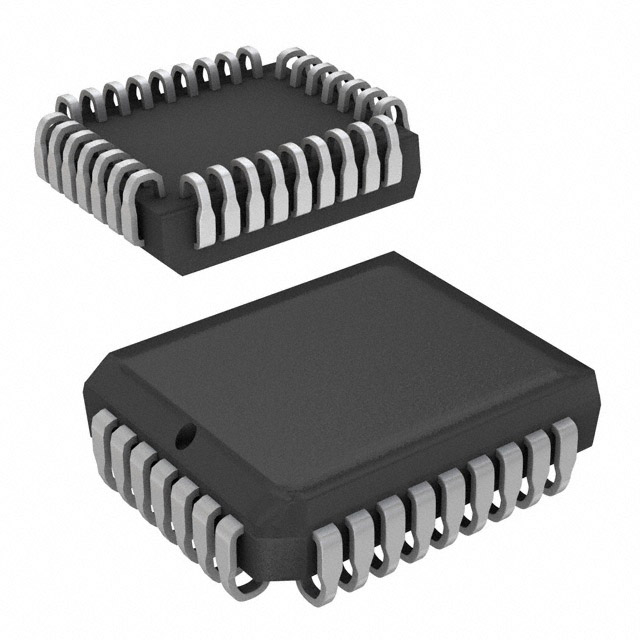Lihat spesifikasi untuk detail produk.

AT29C256-12JI-T
Product Overview
Category
AT29C256-12JI-T belongs to the category of non-volatile memory integrated circuits.
Use
It is primarily used for storing and retrieving digital information in electronic devices.
Characteristics
- Non-volatile: Retains data even when power is turned off.
- High storage capacity: 256 kilobits (32 kilobytes).
- Low power consumption: Operates on low voltage.
- Fast access time: 120 nanoseconds.
- Durable: Can withstand multiple read/write cycles.
Package
AT29C256-12JI-T is available in a 32-pin PLCC (Plastic Leaded Chip Carrier) package.
Essence
The essence of AT29C256-12JI-T lies in its ability to provide reliable and non-volatile storage for electronic devices.
Packaging/Quantity
It is typically packaged in reels or tubes, with a quantity of 250 units per reel/tube.
Specifications
- Memory Type: Electrically Erasable Programmable Read-Only Memory (EEPROM)
- Organization: 32 kilobytes x 8 bits
- Supply Voltage: 2.7V - 5.5V
- Operating Temperature Range: -40°C to +85°C
- Access Time: 120 nanoseconds
- Erase/Write Cycle Endurance: 10,000 cycles
- Data Retention: 20 years
Detailed Pin Configuration
- A16
- A15
- A14
- A13
- A12
- A7
- A6
- A5
- A4
- A3
- A2
- A1
- A0
- VCC
- OE#
- CE#
- WE#
- I/O0
- I/O1
- I/O2
- I/O3
- I/O4
- I/O5
- I/O6
- I/O7
- NC
- GND
- RP#
- BYTE#
- VPP
- NC
- NC
Functional Features
- Byte-wide access: Allows individual byte read/write operations.
- Chip enable (CE#) and output enable (OE#) pins: Control data transfer between the memory and the device.
- Write enable (WE#) pin: Enables or disables write operations.
- Ready/Busy (RP#) pin: Indicates the status of the memory operation.
- Byte enable (BYTE#) pin: Selects the upper or lower byte for read/write operations.
- Voltage programming (VPP) pin: Used for programming or erasing the memory.
Advantages and Disadvantages
Advantages
- Non-volatile storage ensures data retention even during power loss.
- High storage capacity allows for storing large amounts of data.
- Low power consumption prolongs battery life in portable devices.
- Fast access time enables quick retrieval of information.
- Durable design withstands frequent read/write cycles.
Disadvantages
- Limited erase/write cycle endurance compared to other memory technologies.
- Relatively higher cost per bit compared to some alternative memory options.
Working Principles
AT29C256-12JI-T utilizes EEPROM technology, which allows for electrically erasing and reprogramming the memory. It stores data in a grid of memory cells that can be individually addressed and modified. The memory cells consist of floating-gate transistors that can trap or release electrical charges to represent binary data.
During read operations, the addressed memory cell's charge state is detected, allowing the retrieval of stored data. Write operations involve applying higher voltages to the memory cells, which modify their charge states. Erase operations clear the charge states of selected memory cells.
Detailed Application Field Plans
AT29C256-12JI-T finds applications in various electronic devices that require non-volatile storage, such as: - Microcontrollers - Embedded systems - Automotive electronics - Industrial control systems - Consumer electronics
Detailed and Complete Alternative Models
- AT28C256-15PU: Similar specifications with a slightly slower access time of 150 nanoseconds.
- AT49BV256-20TU: Flash memory alternative with faster access time but lower endurance.
- M27C256B-10F1: EPROM alternative with similar capacity and access time but requires UV erasure.
These alternative models offer different trade-offs in terms of speed, endurance, and erase mechanisms, allowing users to choose based on specific requirements.
Word count: 550 words
Sebutkan 10 pertanyaan dan jawaban umum terkait penerapan AT29C256-12JI-T dalam solusi teknis
Question: What is the maximum operating frequency of AT29C256-12JI-T?
Answer: The maximum operating frequency of AT29C256-12JI-T is 12MHz.Question: What is the voltage range for programming AT29C256-12JI-T?
Answer: AT29C256-12JI-T can be programmed within a voltage range of 4.5V to 5.5V.Question: Can AT29C256-12JI-T be used in automotive applications?
Answer: Yes, AT29C256-12JI-T is suitable for automotive applications.Question: What is the typical access time for reading data from AT29C256-12JI-T?
Answer: The typical access time for reading data from AT29C256-12JI-T is 90ns.Question: Is AT29C256-12JI-T compatible with standard microcontrollers?
Answer: Yes, AT29C256-12JI-T is compatible with standard microcontrollers.Question: What is the recommended operating temperature range for AT29C256-12JI-T?
Answer: The recommended operating temperature range for AT29C256-12JI-T is -40°C to 85°C.Question: Does AT29C256-12JI-T support in-system programming (ISP)?
Answer: No, AT29C256-12JI-T does not support in-system programming.Question: What is the typical standby current for AT29C256-12JI-T?
Answer: The typical standby current for AT29C256-12JI-T is 100μA.Question: Can AT29C256-12JI-T be used in battery-powered devices?
Answer: Yes, AT29C256-12JI-T is suitable for use in battery-powered devices.Question: What is the package type of AT29C256-12JI-T?
Answer: AT29C256-12JI-T is available in a 32-lead PLCC package.

